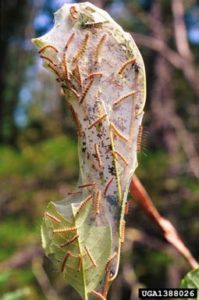Having caterpillars infest your trees can be a worrying situation for a homeowner. Caterpillars can do lots of damage quickly; however, some types are relatively harmless. The truth is the level of damage your tree will sustain depends on the type of caterpillar, the tree species, and the level of infestation. Luckily, we’ve created a guide of the common caterpillars in the area to help homeowners figure out what type of caterpillar they are dealing with.
 Bagworms
Bagworms
Native to the eastern US, bagworms are defoliating caterpillars that create unsightly cone shaped bags. When populations get high, excessive feeding can strip away large quantities of leaves. Infestations of evergreens typically cause long-term damage and can be deadly to the tree if not treated. Deciduous trees on the other had typically fare better than their evergreen counterparts when infested. Deciduous trees won’t sustain as long-term damage and can typically bounce back after infestation.
Susceptible Trees: arborvitae, fir, hemlock, juniper, pine and spruce, bald cypress, black locust, honey locust, sweetgum and sycamore, boxelder, cotoneaster, maple, elm, buckeye, willow, crabapple, linden, poplar, and many more.
Time of Year: Late Summer
Signs & Symptoms:
- Yellow spots on leaves/needles
- 1-1/2” – 2” cone shaped bags hanging from tree branches (seen in late summer).
- Heavy defoliation
Learn More About Bagworms
 Eastern Tent Caterpillar
Eastern Tent Caterpillar
These hairy insects, with areas of blue, white, black, and orange, are social species that form communal nests in the branches of trees and shrubs. These communal nests look a lot like spider webs and the caterpillars in them can easily defoliate your trees and bushes.
Susceptible Trees: Maples, willows, poplars, cherry, and crabapple.
Time of Year: Spring to Midsummer
Signs & Symptoms:
- Rapid Defoliation
- Easily spread to other shrubs & trees
- Silky nests in the crotches of branches (Sometimes referred to as webs or tents)
- Dark colored larvae visible on the tree and in the nests
Learn More About Eastern Tent Caterpillars
 Cankerworms
Cankerworms
Cankerworms are leaf-chewing caterpillars that attack a variety of hardwoods. Mature, healthy trees may be able to withstand a few years of infestation; however, if you have young, weak, transplanted, or new trees, one infestation of cankerworms can severely damage your tree.
Susceptible Trees: Cankerworms have a wide host range, but prefer elm, apple, dogwood, cherry, a variety of oaks including Willow oak, linden, ash, hickory, hackberry, maple, and beech.
Time of Year: Spring & Fall
Signs & Symptoms:
- Small holes on leaves
- Complete defoliation that leaves the leaf veins intact.
- Limb dieback
- Loss of Vigor
Need Help With Caterpillars?
Meet With A Certified Arborist
Or Call 703-573-3029
 Fall Webworms
Fall Webworms
These webworms are a native pest of shade trees and shrubs similar to Eastern Tent Caterpillar. Fall Webworm are caterpillars that weave webs in trees & shrubs while feeding on their leaves creating huge eyesores. However, because of the time of year these caterpillars feed, webworms are typically not a health concern.
Susceptible Trees: Fall webworms target almost all shade, fruit, and ornamental trees except conifers. In the United States, about 90 species of trees are regularly affected. The most susceptible in our area include hickory, walnut, elm, birch, cherry, redbud, willow, oak, mulberry, crabapple and some maples.
Time Of Year: Late Summer & Fall
Signs & Symptoms:
- Webs constructed around leaves at the end of branches
- Hundreds of larvae, excrement, and dried leaf fragments will be in the webs
- Defoliation
- Young larvae are pale yellow with two rows of black marks along their body
- When fully grown, they are covered in white hairs that originate from black and orange spots
Learn More About Fall Webworms
 Oak Tree Caterpillar / Orange Stripped Oakworm
Oak Tree Caterpillar / Orange Stripped Oakworm
The Orange Stripped Oakworm is a type of caterpillar that is typically found on oak trees. Groups of these skeletonizers devour oak leaves, only leaving behind the veins of the leaf. In heavy infestations, this oak tree caterpillar can completely defoliate a tree by summer.
Susceptible Trees: Oak trees
Time Of Year: Spring
Signs & Symptoms:
- Defoliation
- Black caterpillars with orange stripes on tree (mature oakworms)
- Small, yellow-green caterpillars on tree (young oakworms)
 Sawflies
Sawflies
Sawflies aren’t technically caterpillars, but their larvae do look like caterpillars. If Sawfly infestations are left untreated they will rapidly defoliate many species of trees. Early intervention is key to keep your trees and shrubs from becoming Sawfly victims. Keep an eye out for the warning signs below.
Susceptible Trees: Spruces, Cedars, and Pine trees
Time Of Year: Spring & Summer
Signs & Symptoms:
- Holes or papery spots along leaf midribs
- Skeletonized leaves
- Needles may appear brown and wilted
- Complete defoliation or sparse, patchy, missing foliage
- Caterpillar looking larvae on your trees and shrubs (typically in clusters)
- Stunted tree growth
Learn More About Sawflies
If you are having issues with caterpillars book an appointment with one of our certified arborists or give us a call at 703.573.3029.


